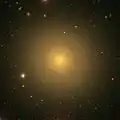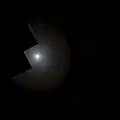| NGC 524 | |
|---|---|
 NGC 524 by Hubble Space Telescope | |
| Observation data (J2000 epoch) | |
| Constellation | Pisces |
| Right ascension | 01h 24m 47.7s[1] |
| Declination | +09° 32′ 20″[1] |
| Redshift | 2403 ± 5 km/s[1] |
| Distance | 86.1 ± 13.7 Mly (26.4 ± 4.2 Mpc)[1] |
| Apparent magnitude (V) | 10.5 |
| Characteristics | |
| Type | SA(rs)0+[1] |
| Apparent size (V) | 2.8′ × 2.8′[1] |
| Other designations | |
| UGC 968, PGC 5222[1] | |
NGC 524 is a lenticular galaxy in the constellation Pisces. It is at a distance of about 90 million light-years away from Earth. In the central bulge of the galaxy is visible gas forming a spiral structure.[2] It is the largest galaxy in the small NGC 524 group of galaxies, which is associated with NGC 488 and its group.[3] It was discovered by William Herschel in 1786.
Two supernovae have been observed in the galaxy, SN 2000cx, a type Ia-p peaking at 14.5 magnitude, and SN 2008Q, type Ia.[4]
Gallery
 NGC 524 (SDSS DR14)
NGC 524 (SDSS DR14) NGC 524 (HST)
NGC 524 (HST)
References
- 1 2 3 4 5 6 7 "NASA/IPAC Extragalactic Database". Results for NGC 524. Retrieved 2006-11-18.
- ↑ "Hubble Eyes a Mysterious Old Spiral". NASA. Archived from the original on 2023-06-09.
- ↑ Dmitry Makarov and Igor Karachentsev (2011). "Galaxy groups and clouds in the local (z~ 0.01) Universe". MNRAS. 412 (4): 2498–2520. arXiv:1011.6277. Bibcode:2011MNRAS.412.2498M. doi:10.1111/j.1365-2966.2010.18071.x. S2CID 119194025.
- ↑ List of Supernovae IAU Central Bureau for Astronomical Telegrams. Retrieved 29 December 2015.
External links
 Media related to NGC 524 at Wikimedia Commons
Media related to NGC 524 at Wikimedia Commons- NGC 524 on WikiSky: DSS2, SDSS, GALEX, IRAS, Hydrogen α, X-Ray, Astrophoto, Sky Map, Articles and images
- SEDS
This article is issued from Wikipedia. The text is licensed under Creative Commons - Attribution - Sharealike. Additional terms may apply for the media files.